Lucky Seryozha Dolinsky
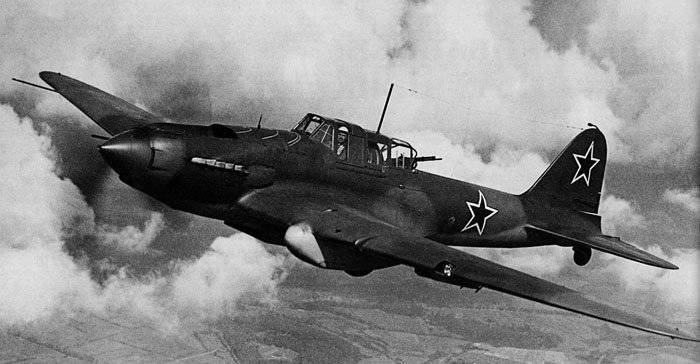
In his childhood, a gypsy woman told him that he would be lucky. It was really like this: the pilot-attack aircraft Sergey Andreevich Dolinsky was never injured or contused. But he learns about this much later.
Today they were raised in alert. They were tasked to fly out and destroy the German units, which began to retreat after the Soviet command launched the 10 in February of 1945, the large-scale East Pomeranian operation, the purpose of which was to destroy the German Army Group Vistula. Its leader, Heinrich Himmler, planned to thwart the advance of the Soviet troops on Berlin, to which the Soviet troops needed to go only 60 kilometers.
But Himmler’s plans did not come true, despite the fact that considerable forces were assembled in Eastern Pomerania, including at the airfields there were about 300 airplanes of various modifications - at the controls of which experienced pilots sat.
Today, February 16, 1945, the Fourth Air Force ground attack aircraft must launch a bomb attack on the retreating units of the Wehrmacht. The war went on the territory of Germany and before its end there were still many days and it would take many more lives, but each of the pilots knew that there would be victory.
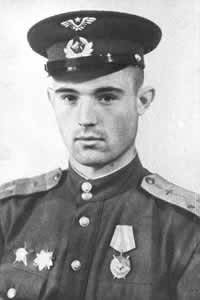 Sergei Dolinsky, along with all dressed in winter uniform. Later tightened the strap on a black leather helmet. Now you can fly. And they flew. German cities and villages were laid down in chessboard form below, but it was all alien and hostile. Below were visible explosions of anti-aircraft shells, but so far they did not harm the attack aircraft.
Sergei Dolinsky, along with all dressed in winter uniform. Later tightened the strap on a black leather helmet. Now you can fly. And they flew. German cities and villages were laid down in chessboard form below, but it was all alien and hostile. Below were visible explosions of anti-aircraft shells, but so far they did not harm the attack aircraft. Dolinsky flew on an IL-2 attack plane, nicknamed "flying a tank", whose armored corps was not a salvation from the fire of German anti-aircraft guns, but reliably protected the pilot and engine from bullets. And as soon as the Germans didn’t call the IL-2 attack aircraft:" butcher "," meat grinder "," iron Gustav "," plague "," Black Death".
When approaching the combat mission, a group of Soviet attack aircraft was attacked by superior enemy forces - 27 "Focke-Wulf FW-190" and "Messerschmitt-109". The Germans boastfully called "Focke-Wulf" stranglers, murderers (Würger him). An unequal battle began. Two German ME-109 fighters attacked the lead group. “Comrade Dolinsky, neglecting the danger to life, from a short distance, he fired down a ME-109 with a fire of guns and machine guns, which turned over and crashed into the ground. Commander Dolinsky's gunner shot down two more enemy fighters.
The plane comrade Dolinsky was hit and caught fire. Tov. Dolinsky turned around with a course of 90 degrees, pulled the front line over the frontline and landed on his own territory, "the pilot told in the award list (published in the archive bank of the document" Feat of People in the Great Patriotic War 1941 – 1945. ").
Similar cases in stories military aviationwhen an attack aircraft fights against German fighters and destroys them - a little because the maneuverability of the fighters is superior to that of attack aircraft. But Russian pilots even on slow-moving attack aircraft defeated the enemy and returned alive to their units. This time, Sergey Dolinsky was also lucky to be back alive. He flew on a damaged plane and every second understood that he had very few chances to reach the location of his regiment.
But he was lucky this time.
“Lucky you, Seryozha,” said his shooter when they were standing with him near the maimed plane.
- And I do not shave before flying, - Sergey answered him half in jest.
The pilots had a sign not to shave and not be photographed before flying. Many people adhered to this rule, but many people died. But all the pilots firmly believed that such a tradition would save them from death.
And the on-board shooter turned out to be really right - Sergey Andreevich Dolinsky was lucky.
He was born in the city of Tikhoretsk, Krasnodar Territory in 1920 year. The boy grew lively and intelligent.
One day, he and his friends played on a country road. Suddenly, a small group of women in colorful skirts appeared - Roma often went to villages and small villages, predicting their fates. But even these national broadcasters could not predict the heavy share that was to be borne by that generation. Little Serezha looked at gypsies with interest. Suddenly, one of them asked the boy for a penny. Serezha did not have money with him.
But the gypsy said that she still lost sight of the boy and told him that he would be lucky.
For some reason, this prediction crashed into the memory of Sergey Andreevich, when he was returning from the next sortie and equipment, inspecting his plane just shrugged and wondered how he flew to his home airfield. And he flew low above the ground, on a low-level flight — it was one of the most dangerous ways to navigate an aircraft — could hit the ground at any time, the aircraft could at any time knock down enemy enemy anti-aircraft artillery: for example, the German anti-aircraft gun Flak 36 minutes to launch 188 shells, and 20-mm Flak 38 - 480 projectiles.
It was especially hard in the early days of the war. Because Sergei Androevich served in the Red Army before the war, designed to serve as the Tikhoretsk city military registration and enlistment office since October 1940, and when eight months later it began he did not have the opportunity to resist in the air, when the German Luftwaffe (Air Force Third Reich) bombed peaceful cities, shot refugees, destroyed military fortifications.
And only in 1942, after graduating from the Voronezh school of junior aviation specialists, was he closer to the sky as part of the fourth air army, which was being created at that time. To further improve the combat experience, Sergey is sent to the Chkalov military aviation school of pilots, they successfully graduate from it in the 1944 year. Almost immediately, he was sent to combat missions as part of the fourth air army.
From June 1944, he finally begins to make combat missions, destroying German trains, cars, fuel and ammunition depots, artillery batteries. And with all this, as follows from the award list, Dolinsky does not have a single injury or contusion.
This fact is all the more surprising because the burden on the pilots' shoulders was enormous - combat sorties, as follows from the pilot’s book, take place almost daily or every other day. And Dolinsky destroys the enemy in each of the flights. So, in the flight book there are three dates when flights were made - 24, 27, 29 of June 1944 of the year. In the area of Bobruisk under heavy fire of German anti-aircraft guns, Sergey Dolinsky three times sets up his own aircraft over enemy positions and destroys six vehicles, a company of soldiers and a gas tanker with fire from two cannon "VY" caliber 23 mm. Also in service with the attack aircraft Il-2 were two ShKAS machine guns (wing), a ShVAK cannon, bombs, missiles PC-82 or PC-132.
And 27 June 1944, he literally flew to the enemy's anti-aircraft battery, but the fire of the German anti-aircraft guns Flak-30 and Flak-38 could not overtake him - Dolinsky himself overtook an anti-aircraft gun and destroyed it. He made one more visit - eight German cars were killed under sighting fire. At this time, two Messerschmitt-109s came to the aid of the fascists, but they could not help either the German troops on the ground or in the air. The pilot skillfully repelled the attack of one of the Messers, and his comrades took up the second.
And again, a day later, an order for a combat sortie follows — 28 June 1944, Dolinsky, with a skillful approach, destroys four vehicles leading ahead of the German motorcade — a traffic jam is created, all the enemy’s military equipment has been destroyed by Soviet aircraft.
The war went on the territory of Germany, which gave a sense of the approach of victory. However, the task fell dangerous and difficult. And in every battle he was threatened with death. "Tov. Dolinsky is a young pilot who, with his brave and skillful actions on his goal, gained deserved fame from pilots. He flies perfectly with great desire and goes into battle with zeal. He knows the fighting equipment and perfectly masters it over the battlefield," - said in award documents .
A week before the end of World War II, 3 on May 1945, Sergey Andreevich makes his last combat sortie, in which he destroyed the enemy's self-propelled barge, and the second was sunk by his comrades who flew as part of the Dolinsky group.
In almost every sortie, Dolinsky has great luck. Because to fly and destroy anti-aircraft batteries and at the same time survive - in this case, we need not only highly professional preparation, but also luck, which, as they say, comes to the strongest.
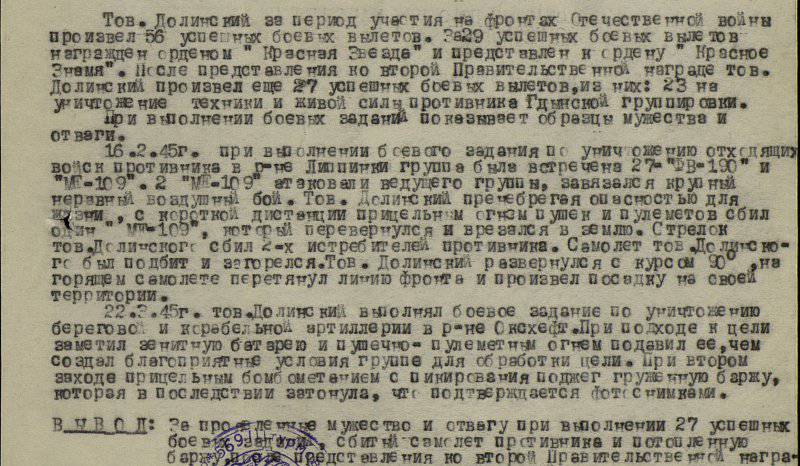
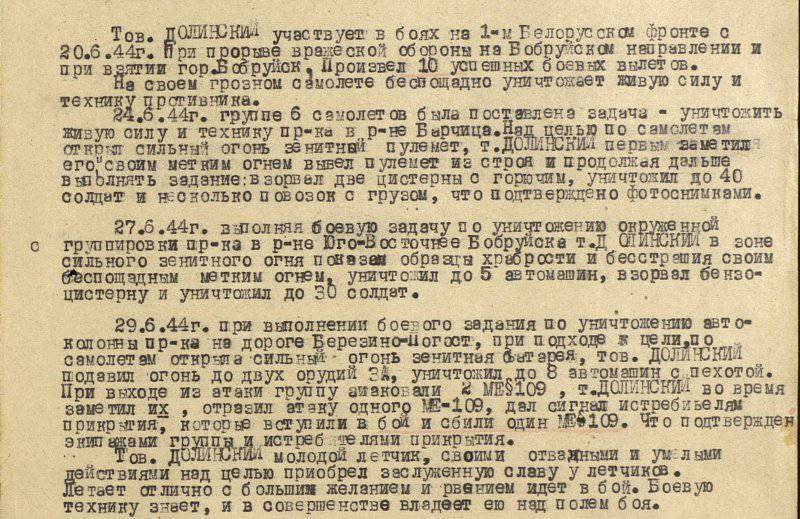
Happy matches were traced even in award documents.
For example, according to the order on 4 of the 18 air army of April 1945 of the year "On awarding personnel" Sergey Andreevich Dolinsky was awarded the Order of the Red Star "for exemplary performance of command assignments at the front of the struggle against the German invaders and shown valor and courage." Surprisingly, the order was signed on May 18, and in the list of recipients the name of Junior Lieutenant Dolinsky is under the 18 number.
In orders you can still find examples of happy coincidence. Thus, the order assigning the title of Hero of the Soviet Union to Dolinsky was signed on May 8 of 1945 of the year, and on May 9 of the order was approved by the commander of the 199 th Red Army Aviation Aviation Division A.Vinogradov. The order lists all combat missions and the circumstances of the destruction of the enemy. Total Sergey Andreevich made 94 combat departure.
The name of Sergey Andreevich Dolinsky is forever inscribed in the history of the Great Patriotic War today.
And then began a peaceful life. There were no sorties, there was no enemy. And Sergey Andreevich, like the majority of war veterans, scorched by the war, for a long time could not get used to the peaceful sky, in which you do not need to turn your plane away from the explosions of projectiles.
He continues to serve in the Air Force. But this service brought him joy - he passed on his vast combat experience to the generation. Sergey Andreevich went to the reserve in 1960 year. And all this time he lived with us almost next door - on Lenin Street, 44 \ 2. Just like we went to work every day, raised children and grandchildren. He was really lucky to stay alive - after all, the military pilots who passed the crucible of the war remained literally few. But these units became the basis for future victories. As well as his peers, he became one of thousands of people, to whose share the terrible ordeal of war fell. And they passed this test.
In August 1993, Sergey Andreevich was gone. In his memory, a memorial tablet was erected on the house where he lived. For many years she hung inviolable and several generations of Rostovites knew and remembered their hero. And then they decided to repair the house. In the course of repair work, which was performed by one of the companies commissioned by the management company, the plate was removed. When activists and veterans of the 4-th Air Army came to celebrate the next anniversary date, they discovered the disappearance of the memorial table and, despite the search, it was never found. It was decided to make and install a new one. And on December 9, 2014, on the Day of the Heroes of the Fatherland, a black and white plaque was solemnly opened. It says: "In this house lived the Hero of the Soviet Union, Sergey Andreevich Dolinsky," and the outline of the Il-2 attack aircraft on which he fought is beaten out below.
On the opening day of the memorial plaque, one of the veterans again spoke of Sergei Dolinsky's luck.
“Sergey Andreevich was a successful man,” said Honored Military Pilot of the USSR, Major General Viktor V. Grishin. - He flew over the ground, the equipment was repaired every day by Dolinsky's plane, but somehow he miraculously stayed alive and fought for the freedom of the Motherland.
Dolinsky Sergey Andreevich - the senior pilot of the 569-th Assault Aviation Regiment of the Osovetsky Red Banner Regiment, junior lieutenant - became one of the heroes in the pantheon of glory, which is scheduled to open on Theater Square in Rostov-on-Don by 9 in May 2015 year. Alexander Kozhin, chairman of the Rostov regional branch of the All-Russian Society for the Protection of Monuments, said during a small press conference on the opening of a memorial plaque, a lot of work is now underway in the city to perpetuate the memory of the heroes of the Soviet Union that are directly related to the city’s historical memory. It is expected that there will be several more memorable tablets on the houses where the Heroes lived. Then all the information will be collected together, summarized and placed on the memorial plates on the Theater Square. So that each person could personally worship the memory of people who fought on the fronts of the Great Patriotic War.
In the photo: IL-2 cabin
1. 2 filling gauge. 3 recharge gauge. The steering wheel of the 4 water deflector. 5 stopcock. Pressure gauge onboard 6. Optional 7 crane. 8 faucet handle. Brake Crane 9. 10 chassis crane handle. 11 height adjustment knob. 12 Normal Gas Handle. 13 trimmer handle. Charge indicators 14. 15 water thermometer. 16 rev counter. Thermometer incoming oil 17. Steering wheel pitch control wheel 18. Steering wheel control aircraft 19. 20 cannon trigger. Sniper for stelby from machine guns 21. Three-pointer 22 indicator. Petrol 23. 24 speed indicator. Variometer 25. 26 altimeter. 27 direction indicator. Navigator 28. Magneto 29 switch. 30 dashboard light switch. Cab light switch 31. Radio 32. Pedal (right) control aircraft 33. 34 electrical control panel. 35 watch. 36 voltmeter. The socket for turning on the backlight PBP-1 37. Signal lights chassis 38. 39 fuse panel. Electrical switch panel 40. 41 fire cock handle. Pressure gauge cylinder launch 42. 43 Emergency Drop Handle. Reflector of a cabin bulb 44. Electric shells ESBR-ZP 45. Electric diverter of bombs ESBR-ZP 46. 47 chassis emergency release handle. Fuel unit (start-up valve, distribution valve, fuel pump plunger, 48 air valve. 49 oil cooler control knob. 50 pneumatic overload safety knob. 51 microtelephone protection knob. 52 crutch stopper.

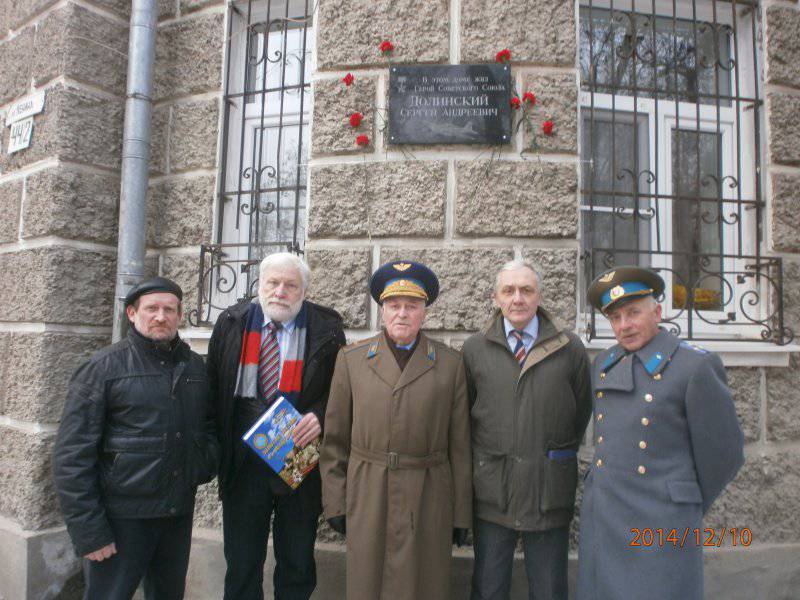
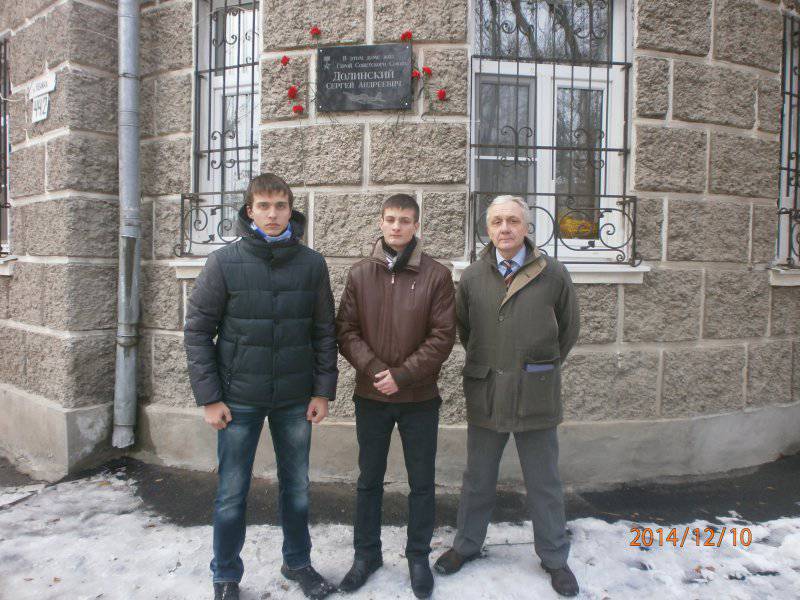
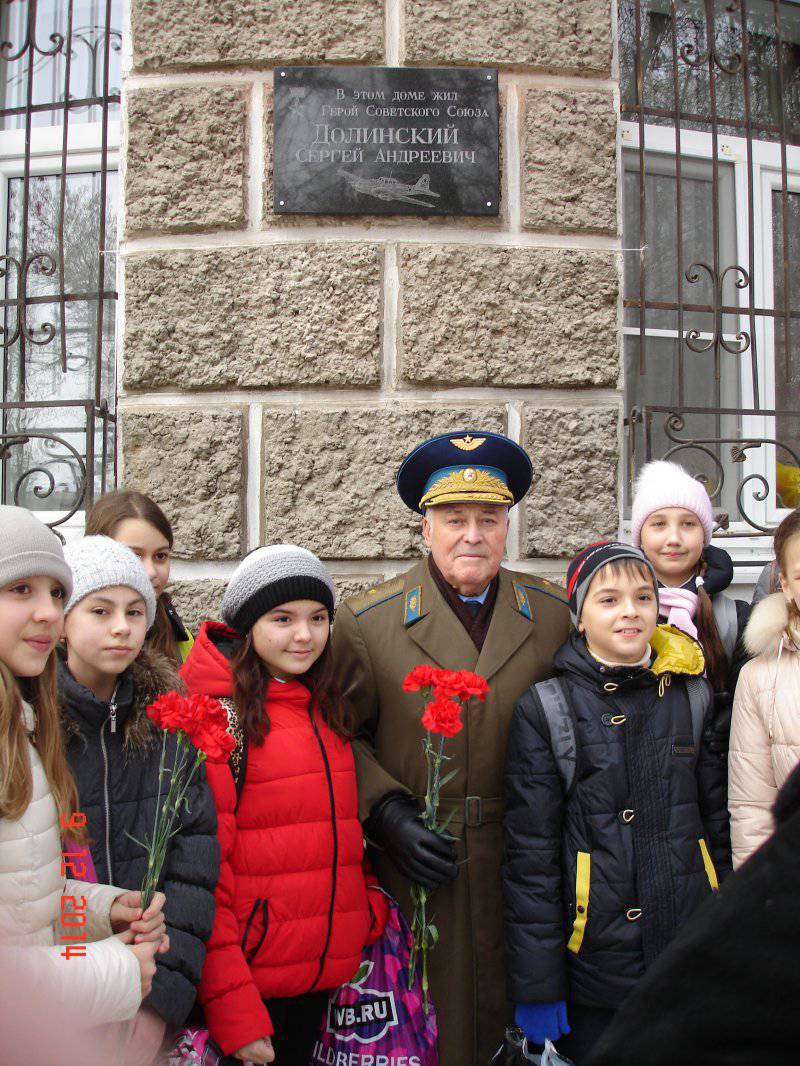
Information